Adrian Collins's Blog, page 33
December 30, 2024
The Most Anticipated TV Shows and Movies of 2025
2024 has been yet another great year for fans of grimdark. Fans of video game adaptations have been thrilled by the excellence of Fallout and Arcane (take a bow Ella Purnell), those who love classic horror have been able to feast on a return to form in Alien: Romulus and the stunning end of year gothic treat that was Robert Eggers’ Nosferatu. Stories continued in House of the Dragon, Dune Part II, Gladiator II, The Rings of Power, and The Boys. My personal favourite of the year had to be Shogun. The award-winning series set in Japan and starring the always amazing Hiroyuki Sanada blew me away – will anything stand up against this masterpiece in 2025?
Here are our most anticipated TV shows and movies for 2025:
The Last of Us Part II The first season was an example of how to adapt a video game. A deep story with compelling characters and genuine scares in a post-apocalyptic world, each episode was filled with greatness. Those who played the second game know what’s coming and if you think the first season was grim and dark, you haven’t seen anything yet…
The first season was an example of how to adapt a video game. A deep story with compelling characters and genuine scares in a post-apocalyptic world, each episode was filled with greatness. Those who played the second game know what’s coming and if you think the first season was grim and dark, you haven’t seen anything yet…
Joel and Ellie’s story isn’t over yet and the darkest parts of their tale have yet to be told.
Watch the trailer for The Last of Us S2 here.
Alien: Earth
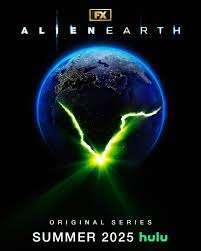 A prequel series set two years before the original film, the hope is that this new series will have the quality of this year’s Alien: Romulus as the tense horror returns to the franchise. A mysterious space vessel crash lands on Earth pitting a ragtag group of humans against a deadly threat…
A prequel series set two years before the original film, the hope is that this new series will have the quality of this year’s Alien: Romulus as the tense horror returns to the franchise. A mysterious space vessel crash lands on Earth pitting a ragtag group of humans against a deadly threat…
Watch the teaser trailer for Alien: Earth here.
Alice in Borderland S3
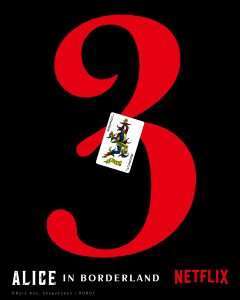 The third season of the Japanese hit continues Arisu’s struggle in Tokyo as he and his allies are forced to compete in games for their survival as they attempt to unravel the mystery that has bugged them since the first season. Season 2 was a jump in quality and really brought some depth to the story with some excellent writing and unique games used each episode. I can’t wait for season 3!
The third season of the Japanese hit continues Arisu’s struggle in Tokyo as he and his allies are forced to compete in games for their survival as they attempt to unravel the mystery that has bugged them since the first season. Season 2 was a jump in quality and really brought some depth to the story with some excellent writing and unique games used each episode. I can’t wait for season 3!
American Primeval
 Described as a brutal western set in the 1800’s, this series has so much potential to be your next favourite. The latest series from Netflix is a dramatization & examination of the violent collision of culture, religion, and community as men and women fight and die to keep or control their land. Peace and compassion is rare in this series starring Taylor Kitsch and Betty Gilpin.
Described as a brutal western set in the 1800’s, this series has so much potential to be your next favourite. The latest series from Netflix is a dramatization & examination of the violent collision of culture, religion, and community as men and women fight and die to keep or control their land. Peace and compassion is rare in this series starring Taylor Kitsch and Betty Gilpin.
Watch the trailer for American Primeval here.
Predator: Badlands
Dan Trachtenburg brought us the best Predator in years with Prey. His next effort is Badlands and it will be interesting to see if he can build on the goodwill earned in his Native American Predator film with this story of two sisters discovering horrors on an alien wasteland.
Mickey 17 Directed by Bong Joon-Ho (Parasite) and starring Robert Pattinson (The Batman, The Lighthouse), this dark film is about a man who gets away from Earth to be an expendable, a disposable employee who is replaced by a clone with each death. When version 17 survives, it causes problems for the next iteration… With an incredible director and a main star known for choosing interesting scripts, this will be well worth a watch in 2025.
Directed by Bong Joon-Ho (Parasite) and starring Robert Pattinson (The Batman, The Lighthouse), this dark film is about a man who gets away from Earth to be an expendable, a disposable employee who is replaced by a clone with each death. When version 17 survives, it causes problems for the next iteration… With an incredible director and a main star known for choosing interesting scripts, this will be well worth a watch in 2025.
Watch the trailer for Mickey 17 here.
The post The Most Anticipated TV Shows and Movies of 2025 appeared first on Grimdark Magazine.
December 29, 2024
INTERVIEW: Sevier Crespo Producer of Werewolves
Sevier Crespo is an award-winning actor, producer, and writer. He recently had a conversation with Grimdark Magazine’s C.T. Phipps to discuss his latest project, the horror film Werewolves.
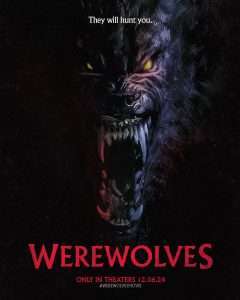 [GdM] Thank you Sevier for agreeing to chat with us about Werewolves. First off, can you tell us the premise for Werewolves for readers who haven’t heard of the film?
[GdM] Thank you Sevier for agreeing to chat with us about Werewolves. First off, can you tell us the premise for Werewolves for readers who haven’t heard of the film?
[SC] At some point in the past, a supermoon triggered something in humans that caused anyone exposed to transform into werewolves. This resulted in millions being killing overnight. And now there’s another supermoon approaching. Scientists are desperately trying to figure out the cause of this phenomenon in order to save civilization.
[GdM] You’ve described it as “The Purge meets Werewolves.” What elements of The Purge get combined with lycanthropy?
[SC] There’s the annual night of chaos and killing in The Purge. It’s known that it’s coming, not unlike Werewolves where we know the super moon is coming and we know what that means. Probably the element that gets combined is the primal horror of The Purge as compared to the lycanthropy of Werewolves. It forces people to prepare for mass chaos. But instead of human violence, it’s triggered by the werewolf transformations. In both films there are moral dilemmas, like how to survive when loved ones turn against you. Also, social and economic factors that come into play, where the rich have more resources to protect themselves than those of lesser means. It’s all about survival.
[GdM] Katrina Law (NCIS), Ilfenesh Hadera (Godfather of Harlem), and Lou Diamond Phillips (Prodigal Son, Longmire) are also in the film. Do you have any details you’d like to share about one or two of their characters?
[SC] Katrina Law’s character is Frank’s colleague and they have to work together to survive, while Lou is a scientist working to discover how to save humanity. Ilfenesh is Frank’s sister-in-law that fights to protect her daughter from the werewolves led by Cody, the vindictive neighbor turned werewolf.
[GdM] What sort of special effects were necessary to create a world of werewolves?
[SC] Everything was done as practical as possible. The team was led by Alec Gillis and Tom Woodruff Jr., known for their work on Alien and Predator. There was a lot of work and thought put into the authenticity of the werewolf transformations by those that had massive experience with make-up, animatronics, and other special effects.

Werewolves Producer Sevier Crespo
[GdM] How dark would you say the movie gets? Is it action horror or just plain horror?
[SC] It’s an action horror/thriller that gets dark. There are a lot of elements from those genres that are combined in a really fun and creative way. It’s definitely an all-around, entertaining film.
[GdM] Will there be any humor in Werewolves?
[SC] I think the characters are grounded in reality, but depending on your sense of humor, some viewers may find some things funny, while others may not.
[GdM] What can fans of horror expect from this film?
[SC] Werewolves has some really cool throwback monsters and suspenseful moments. I feel like audiences are sophisticated enough notice there is something lacking when films use CGI and visual effects. We have real, live 6’ 7’’ athletes and talent inside these ginormous outfits roaming around in 100-degree weather at night. There’s a reality to it. If they are annoyed, angry, thirsty, or hot, it’s coming across because of the actors and the practical aspect of the werewolves. I think there’s something really cool about that.
[GdM] Our audience is drawn to dark and gritty films—what is it about Werewolves that will appeal to them?
[SC] It’s not a bubbly movie, that’s for sure. The film dives into the darker side of our world, tackling issues like pollution in our environment and how society is struggling more and more to uphold basic human rights. The gaps of the “haves” and the “have-nots” are increasing dramatically and the film touches on that too.
[GdM] What makes Werewolves stand out from monster movies?
[SC] To me, the wolves are everything. They’re awesome. The talent that portrays them did such a phenomenal job. I can’t really recall a movie, outside of Predator or Aliens, where they used honest to goodness, bad-to-the-bone animatronics like this. It makes it so fun. That, to me, differentiates it from other horror films. Werewolf-wise, I haven’t seen anything like this since American Werewolf in London.
[GdM] There have been many stories involving werewolves throughout history. Is there a film or story that has been a big influence on Werewolves?
[SC] I think our director Steven C. Miller would have something to say on this. I’d say American Werewolf in London was a big one because of the practicality they achieved. To me it was next level for its time and seemed unbeatable.
[GdM] Thank you so much to Sevier Crespo for taking the time to chat with us. Werewolves was released in the USA on December 6th 2024
Watch WerewolvesThe post INTERVIEW: Sevier Crespo Producer of Werewolves appeared first on Grimdark Magazine.
December 28, 2024
REVIEW: The Prince Without Sorrow by Maithree Wijesekara
The Prince Without Sorrow is the debut novel by author Maithree Wijesekara. Its publisher, Harper Voyager, describes it as ”the debut fantasy sensation of 2025” and says it is perfect for Hannah Kaner and Samantha Shannon fans. That was enough information to pick it up and dive into this new world. That and the giant leopards and flying serpents also piqued my interest.
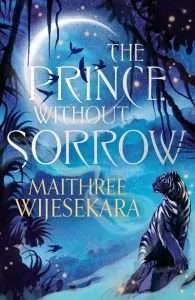 Set in the Ran Empire and inspired by Emperor Ashoka of the Mauryan Dynasty of Ancient India, The Prince Without Sorrow has two points of view that we follow. The first is the witch Shakti, a mayakari trained to commune with nature and do no harm. But the emperor has persecuted Shakti’s people for decades, burning mayakari alive (or worse) if he finds them. Choosing violence might be the only way Shakti can keep her people safe. The other perspective is that of Prince Ashoka, the youngest child of the brutal emperor. Ashoka has been raised to be cruel and cunning; his family sees his pacifist choice as weak and childish. Ashoka would do anything to tear apart his father’s legacy. But there is always violence in destruction, no matter how hard you strive for a peaceful resolution.
Set in the Ran Empire and inspired by Emperor Ashoka of the Mauryan Dynasty of Ancient India, The Prince Without Sorrow has two points of view that we follow. The first is the witch Shakti, a mayakari trained to commune with nature and do no harm. But the emperor has persecuted Shakti’s people for decades, burning mayakari alive (or worse) if he finds them. Choosing violence might be the only way Shakti can keep her people safe. The other perspective is that of Prince Ashoka, the youngest child of the brutal emperor. Ashoka has been raised to be cruel and cunning; his family sees his pacifist choice as weak and childish. Ashoka would do anything to tear apart his father’s legacy. But there is always violence in destruction, no matter how hard you strive for a peaceful resolution.
I enjoyed much of The Prince Without Sorrow. The comparisons between Hannah Kaner and Samantha Shannon feel apt, so if you enjoy their style, you will enjoy Wijesekara’s, too. The fantasy world in The Prince Without Sorrow is very promising, and I hope the reader will learn more about it as the series continues. As the first novel in a series, Wijesekara has built an excellent foundation for the characters and the world. The Prince Without Sorrow isn’t a chunky Priory of the Orange Tree size novel, and I look forward to more details as we progress with later books.
Wijesekara doesn’t entirely shy away from the darker elements in The Prince Without Sorrow; the descriptions of the torture of mayakari and his father’s treatment of Prince Ashoka were uncomfortable to read. But I wouldn’t put it on my grimdark shelf. The Prince Without Sorrow is a good fantasy novel with some darker parts and moral ambiguity. Wijesekara poses many ethical questions to the reader and leaves it up to them to decide whether they are acceptable. Is it permissible to harm one if that saves many? Is revenge right? Is it nonviolent if inaction causes further harm? The characters in The Prince Without Sorrow must face all these questions, as does the reader, and we are both still trying to decide the answer by the end of it.
Some parts of The Prince Without Sorrow left me wanting more, and I hope they will be elaborated on later in the series. For example, it’s never really explained why Emperor Adil is persecuting the mayakari or why he is particularly cruel to Ashoka and not his other children. Wijesekara does hint in the direction of these issues, though, and if I weren’t left wanting more at the end of the first novel in a series, then I’d have no reason to pick up the next. As a main character, I’m also not entirely invested in Shakti or Ashoka. They make good foils for one another, but I want a little more than ‘I’ve been raised to be a pacifist, but I don’t agree’ versus ‘I’ve been raised to be violent but want to be a pacifist’ to make me go in to bat for the characters. However, both characters are relatively young, and this is the opening book in a series, so again, I am hopeful this is a deliberate choice to set up the characters ‘ later development.
The Prince Without Sorrow is an auspicious debut and a fun exploration of a new fantasy world. I look forward to reading Wijesekara’s next instalment of her Obsidian Throne series. I want to thank both Harper Voyager and Maithree Wijesekara for sending the Grimdark Magazine team an ARC to provide this review.
Read The Prince Without SorrowThe post REVIEW: The Prince Without Sorrow by Maithree Wijesekara appeared first on Grimdark Magazine.
December 27, 2024
REVIEW: Contra Amatores Mundi by Graham Thomas Wilcox
Contra Amatores Mundi: A Gothic Fantasy is a medieval grimdark novella by Graham Thomas Wilcox, one of the editors behind the “Soulsborne” dark fantasy fiction showcase Old Moon Quarterly. The title is Latin for “against the lovers of the world,” quoted from a sermon by 14th century religious writer Richard Rolle, and true to the name, the novella features a pair of lovers separated by epic circumstances.
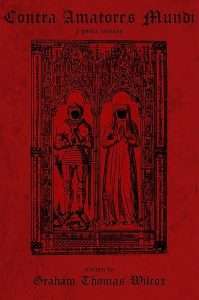 Contra Amatores Mundi begins with Hieronymus of Tsorn and Prospero of Luchetti, two knights of the chivalric Order of the Dragon, at sea. As they dispatch their enemy, the Knight of Foxes, he drags both knights overboard as his dying act. The last thing Hieronymus sees as he is claimed by the depths is Walpurga, his beloved nun (who has one flesh hand and one skeletal hand for unexplained—but undeniably metal—reasons). When Hieronymus and Prospero awaken, they find themselves in a strange world beneath the sea. With only each other to rely upon in a bizarre land swarming with hostile monsters, the two knights set out across the wilderness, searching for a way home. Through the use of a relic claimed from the corpse of their first opponent, Hieronymus witnesses visions of his distant love Walpurga. Alternately comforting and distressing, on some occasions he sees Walpurga doing her utmost to be reunited with Hieronymus, at other times he sees her committing infidelities or moving on with her life. Just as the vicissitudes of their journey tests his body, the visions challenge his resolve and love for his woman.
Contra Amatores Mundi begins with Hieronymus of Tsorn and Prospero of Luchetti, two knights of the chivalric Order of the Dragon, at sea. As they dispatch their enemy, the Knight of Foxes, he drags both knights overboard as his dying act. The last thing Hieronymus sees as he is claimed by the depths is Walpurga, his beloved nun (who has one flesh hand and one skeletal hand for unexplained—but undeniably metal—reasons). When Hieronymus and Prospero awaken, they find themselves in a strange world beneath the sea. With only each other to rely upon in a bizarre land swarming with hostile monsters, the two knights set out across the wilderness, searching for a way home. Through the use of a relic claimed from the corpse of their first opponent, Hieronymus witnesses visions of his distant love Walpurga. Alternately comforting and distressing, on some occasions he sees Walpurga doing her utmost to be reunited with Hieronymus, at other times he sees her committing infidelities or moving on with her life. Just as the vicissitudes of their journey tests his body, the visions challenge his resolve and love for his woman.
Contra Amatores Mundi bears some kinship with an earlier work by Wilcox, sharing the setting and some characters from “The Feast of Saint Ottmer,” my favorite of the stories published in Old Moon Quarterly Volume 3. In my review of “The Feast of Saint Ottmer,” I wrote that “It overshoots Arthurian romance, ending up closer to the opening scenes of Vlad Dracula as armored warrior in the Francis Ford Coppola film Bram Stoker’s Dracula (1992).” To my amusement, Wilcox later admitted that he was indeed a big fan of that particular Coppola sequence, and the same bombastic, operatic feel is captured in Contra Amatores Mundi as well.
Wilcox cites Cormac McCarthy, Gene Wolfe, and Chretien de Troyes as influences on Contra Amatores Mundi. While I lack firsthand experience with Chretien, I can say that the novella does pair the brutality of something like McCarthy’s The Road with the ornate prose and archaic diction of Wolfe’s The Book of the New Sun. Intriguing vocabulary choices abound, and the style of passages like the following effectively evoke an atmosphere where flowery, cultured speech collides with the grim butchery of the knights’ trade.
“…violence never authored its writ upon a man more firmly than it did upon dread Prospero. Blood, fire and death had scrawled him all over, such that by the very ink of his eye and curl of his mouth, one branded him at once a son of Cain.”
Hieronymus and Prospero’s odyssey is a bloody, arduous one. At every turn they are confronted by giants, animate skeletons, serpent-headed creatures and worse. Their nightmarish journey is accompanied by frequent meditations upon the nature of their vocation. These knights fight in the name of the Christian God (presented here as a more martial and bloodthirsty icon than some might expect), and Hieronymus is simultaneously devoted to the darkly alluring Walpurga. But the reader is also given the impression that these two warriors relish the taking and giving of blood. They are compatible with no other lifestyle; killing is their business and business is good. And trapped as they are in another realm with only a faint glimmer of hope, they have effectively become suicide commandos.
While readers may trip over the occasional unfamiliar word (likely armor-related jargon) or pause to reread a particularly florid turn of phrase, the pace of the novella is brisk and propulsive. The ending arrives abruptly. So sudden, in fact, that I wondered if my copy was missing a page or two. Upon further reflection, however, Wilcox gives us enough indication of the two knights’ ultimate fate, allowing readers to fill in the final moments themselves.
The McCarthy and Wolfe influences are clearly present, but this novella is also recommended for fans of Christopher Buehlman’s Between Two Fires, Matt Holder’s Hurled Headlong Flaming, and the Games Workshop Warhammer tie-in fiction published by Black Library. (Indeed, one of Wilcox’s previous releases is the Warhammer: Age of Sigmar short story “Grimnirsson.”) Contra Amatores Mundi: A Gothic Fantasy is a gory grimdark opera with style and spectacle.
Read Contra Amatores Mundi: A Gothic Fantasy by Graham Thomas WilcoxThe post REVIEW: Contra Amatores Mundi by Graham Thomas Wilcox appeared first on Grimdark Magazine.
December 26, 2024
REVIEW: Lightfall by Ed Crocker
If you thought vampires and werewolves in epic fantasy were dead, then Ed Crocker is here to prove you wrong in Lightfall. Bleeding with intrigue, emotion, and snarky dark humour, this fangtastically fun yet bloody brutal dark fantasy will ensorcell you with its mystery and have you howling from laughter and heartache the entire way through. 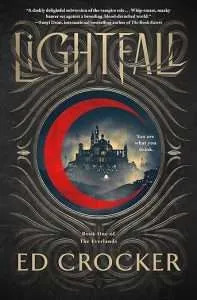 In a world where mortals are myth, a rebellious vampire maid, a magicless sorcerer and his rakish companion, a pompous and grieving vampire Lord, a secretive vampire countess and her enigmatic lady friend, and a deadly werewolf assassin cross paths as they stumble into a seemingly simple murder mystery investigation that unearths a dark conspiracy which turns their entire world on its head; it’s not the start of a bad joke, it’s the batshit crazy premise of Lightfall.
In a world where mortals are myth, a rebellious vampire maid, a magicless sorcerer and his rakish companion, a pompous and grieving vampire Lord, a secretive vampire countess and her enigmatic lady friend, and a deadly werewolf assassin cross paths as they stumble into a seemingly simple murder mystery investigation that unearths a dark conspiracy which turns their entire world on its head; it’s not the start of a bad joke, it’s the batshit crazy premise of Lightfall.
Now, it might have taken me a few chapters to really sink into the narrative because of the frequent mid-chapter POV switches, but once I was in, I was IN. Crocker’s bold storytelling and whip-smart authorial voice just worked for me in every single way, and I personally think he pulled off the tricky multi-POV first person present tense narration with effortless grace. The way that the prose subtly shifted in tone and diction to fit with the race, cultural background and class of each character was so masterfully done and made them all so distinct and uniquely compelling, even if some of them were maybe a bit overwhelmingly wordy or had a flair for the dramatic that probably even Gabriel de Léon and Jean-François from Kristoff’s Empire of the Vampire would roll their eyes at.
Honestly though, for a book that Crocker promotes as ‘anti-human propaganda’, it is filled with suspiciously lively and inexplicably loveable weirdos whose raw and relatable (in?)human emotions get you emotionally invested to a point that is honestly not safe for your own sanity. I loved seeing unexpected bonds of loyalty and friendship (and maybe even more? CUTE) tentatively start to develop between them, despite their best efforts to pretend they truly absolutely didn’t care for each other (nice try). And don’t get me started on how much I adored all the fierce, feisty and fearsome ladies, they just truly stole the show for me in Lightfall. From the rebellious Sam and her quietly endearing friend Beth, to the deviously clever and enigmatic Lady Hocquard and Alanna, and can’t forget the snarky and deadly werewolf assassin Raven Ansbach; I want to be them all when I grow up.
And when I tell you that this story just gets better and better with each chapter, I mean that it got so good that I couldn’t hold myself back from devouring the last half of the book in one afternoon. Lightfall isn’t just a fantasy mystery, but instead it’s also got a truly addictive air of mystery and intrigue that permeates every aspect of the story. Crocker just knows how to strike the perfect balance between giving enough information to feel deeply immersed and follow along with all the mystifying clues of the mystery investigation, while also keeping his cards deviously close to his chest and dangling just the most tantalising teases about the rich history/lore of the world and the obscure backstories of the enigmatic characters in front of your nose.
Moreover, for all that Lightfall is a wildly entertaining and exciting romp (we’ve even got a suicide mission of a blood bank heist, for goodness’ sake), at its core it’s still a dark fantasy with good horror flavours which unflinchingly explores some heavier topics and knows how to deliver emotional gutpunches that just hurt oh so good. When you’re dealing with a world ruled by immortal beings, the themes of mortality, the fallibility of memory and historical accounts, and the weight of grief and grudges naturally sneak their way into the narrative in the most unexpectedly hard-hitting and profound ways. Not to mention the commentary on classism and elitism through the set-up of the vampire society, where the nobility thrive on the most nurturing and powerful blood while the poor are left to wither away on the weak blood; even in a society of vampires, you can count on the rich to be the true suckers.
Just when I thought we had twisted the last twist and turned the last turn, Crocker had another few corkscrews up his sleeve, and the last chapter of Lightfall truly has me dying for book 2 in The Everlands trilogy already. With its high stakes, riveting mystery, pulse-pounding action, and irresistibly charming humour and heart, this comfortably familiar yet refreshingly inventive dark fantasy mystery adventure is just the perfect treat for all the dark souls who love the tone and vibe of David Wragg, Jay Kristoff, and Joe Abercrombie; I can’t recommend it highly enough!
Thank you to the author and St. Martin’s Press for providing me with an eARC in exchange for an honest review. All opinions are my own. Lightfall is scheduled for release on January 14, 2025.
Read Lightfall by Ed Crocker
The post REVIEW: Lightfall by Ed Crocker appeared first on Grimdark Magazine.
December 25, 2024
The best fantasy, horror, and Sci-fi books of 2024
Last Updated on December 26, 2024
When I asked the team for the best science fiction, fantasy, and horror books of 2024, I expected a bit of a mixed bag. There is some absolutely epic reading coming out in 2025 but this year felt, at first, like it had been a little lean in the grimdark and dark SFF world. Seeing what the team enjoyed reading this year, I, of course, was wrong.
It’s easy to forget across the course of a whole year, 300+ book reviews, and all the other things released around the book world that there has been some amazing reading published this year. Even looking back our favourite reads of 2024 so far in July, I should have known better.
Fortunately for you, the team has come up with a list for the ages, with plenty in there for a wide range of readers, all with the things we know you love–grim stories set in a dark world told by morally grey characters. Sit back this Boxing Day, and pick a few books to pad out your TBR pile.
Empire of the Damned by Jay KristoffPicked by Fiona
 My best read of 2024 was Jay Kristoff‘s Empire of the Damned, which should surprise no one because it was also my most anticipated read for 2024.
My best read of 2024 was Jay Kristoff‘s Empire of the Damned, which should surprise no one because it was also my most anticipated read for 2024.
The second book in a trilogy often has a tough time, but Empire of the Damned is more than a bridge between the fantastic Empire of the Vampire and what promises to be an epic conclusion. It is as dark, bloody, and brutal as you would expect from a world full of fanged apex predators. But it’s also got hope, love, and some moments of hilarity. Sometimes people think that grimdark is the absence of those lighter moments, but in them Kristoff shows us why Gabe is still fighting, why he hasn’t given up, and why he will continue until the bitter and bloody end. Gabriel de Leon is not a hero, he’s never claimed to be, but he will tear down the world around him for those he loves. Empire of the Damned was exceptional and I can’t wait for Kristoff’s finale.
P.S. the internal artwork from Bon Orthwick is beautiful.
Read our review of Empire of the Damned by Jay Kristoff.
About Empire of the DamnedFrom holy cup comes holy light;
The faithful hands sets world aright.
And in the Seven Martyrs’ sight,
Mere man shall end this endless night.
Gabriel de León has saved the Holy Grail from death, but his chance to end the endless night is lost. Drawn into an uneasy alliance with the mysterious vampire Liathe, Gabriel must now deliver the Grail to ancients of the Blood Esani, and learn the truth of how Daysdeath might be finally undone.
But the Last Silversaint faces peril, within and without. Pursued by terrors of the Blood Voss, drawn into warfare between the Blood Dyvok and duskdancers of the frozen Highlands, and ravaged by his own rising bloodlust, Gabriel may not survive to see the Grail learn her truth.
And that truth may be too awful for any to imagine.
Read Empire of the DamnedThe Book that Broke the World by Mark LawrencePicked by John
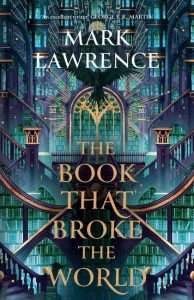 The Book That Broke the World? More like the book that broke my brain and shattered my soul. Mark Lawrence strikes the perfect balance between intellect and heart in this second volume of his Library Trilogy, which began with last year’s highly acclaimed The Book That Wouldn’t Burn. The Library Trilogy revolves around the Athenaeum, the legendary library that becomes a literal and figurative battleground over who controls access to knowledge or whether information should be passed down at all.
The Book That Broke the World? More like the book that broke my brain and shattered my soul. Mark Lawrence strikes the perfect balance between intellect and heart in this second volume of his Library Trilogy, which began with last year’s highly acclaimed The Book That Wouldn’t Burn. The Library Trilogy revolves around the Athenaeum, the legendary library that becomes a literal and figurative battleground over who controls access to knowledge or whether information should be passed down at all.
Enter Livira, an irrepressible young woman who, like the resilient weed for which she is named, simply cannot be kept down. Despite coming from an impoverished background and suffering unspeakable tragedy as a young girl, Livira overcomes the odds to become a librarian in the bustling Crath City. The other lead protagonist is Evar, a young man who grew up trapped in the Library, surrounded by impossibly tall towers of books, with only his four adopted siblings as companions. The Library children were raised by two android-like figures known as the Assistant and the Soldier.
The Book That Broke the World is a triumph of imagination and a deeply thought-provoking meditation on the nature of memory, the value of knowledge, and the degree of self-determination we may or may not have in our lives. Do we write our own stories or are they written for us? I, for one, couldn’t be happier that Mark Lawrence has written this masterpiece for us all.
Read our review for The Book that Broke the World by Mark Lawrence.
About The Book that Broke the WorldThe Library spans worlds and times. It touches and joins distant places. It is memory and future. And amid its vastness Evar Eventari both found, and lost, Livira Page.
Evar has been forced to flee the library, driven before an implacable foe. Livira, trapped in a ghost world, has to recover the book she wrote—one which is the only true threat to the library’s existence—if she’s to return to her life.
While Evar’s journey leads him outside into a world he’s never seen, Livira’s path will taker her deep inside her own writing, where she must wrestle with her stories in order to reclaim the volume in which they were written.
The secret war that defines the library has chosen its champions and set them on the board. The time has come when they must fight for what they believe, or lose everything.
Read The Book that Broke the WorldAsunder by Kerstin HallPicked by Esmay
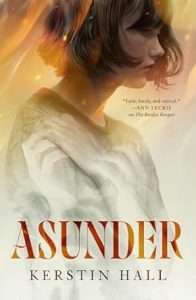 If you’d asked me at the start of 2024 which book would end up my no. 1 favourite of the year, I would have pulled up a crazily long list of highly anticipated reads that I would have bet good money on taking the crown. But then, out of absolutely nowhere, Asunder by Kerstin Hall entered my life and just ran away with my heart, only to crush it without remorse and then leave me desperately trying to pick up the pieces.
If you’d asked me at the start of 2024 which book would end up my no. 1 favourite of the year, I would have pulled up a crazily long list of highly anticipated reads that I would have bet good money on taking the crown. But then, out of absolutely nowhere, Asunder by Kerstin Hall entered my life and just ran away with my heart, only to crush it without remorse and then leave me desperately trying to pick up the pieces.
This dark fantasy horror adventure follows Deathspeaker Karys Eska after she accidentally binds a dying stranger into her shadow when her latest job goes horribly wrong; a bond that could end up tearing them both asunder. This is one of those books that you can’t do justice to in a review or recommendation, you have to experience its brilliant madness, peel back the characters’ emotional layers, and explore the obscure corners of this hauntingly mesmerising world all for yourself.
Hall’s bold storytelling and unique imagination are unlike anything I have ever had the pleasure of experiencing before, and the diabolical ending still has me reeling all these months later. Filled with arcane horrors, eldritch beings, emotional trauma, and broken yet loveable characters who are scattered all across the spectrum of grey morality, Asunder is honestly an unparalleled masterpiece of character-driven grimdark fantasy with heart.
Read our review of Asunder by Kerstin Hall.
About AsunderKarys Eska is a deathspeaker, locked into an irrevocable compact with Sabaster, a terrifying eldritch being―three-faced, hundred-winged, unforgiving―who has granted her the ability to communicate with the newly departed. She pays the rent by using her abilities to investigate suspicious deaths around the troubled city she calls home. When a job goes sideways and connects her to a dying stranger with some very dangerous secrets, her entire world is upended.
Ferain is willing to pay a ludicrous sum of money for her help. To save him, Karys inadvertently binds him to her shadow, an act that may doom them both. If they want to survive, they will need to learn to trust one another. Together, they must journey to the heart of a faded empire, all the while haunted by arcane horrors, and the unquiet ghosts of their pasts.
And all too soon, Karys knows her debts will come due.
Read AsunderThe Daughter’s War by Christopher BuehlmanPicked by Will
 The Daughter’s War by Christopher Buehlman was my favorite of 2024. The main character, Galva, had one of the most compelling voices I’ve read in fantasy. I was refreshed by a character driven story set in an epic war story, and Buelman’s arresting writing style kept me in the story the whole time. Throw in massive, sentient war ravens and a goblin horde comprised of the most gruesomely terrifying creatures in a fantasy world, and you have my favorite grimdark novel in years.
The Daughter’s War by Christopher Buehlman was my favorite of 2024. The main character, Galva, had one of the most compelling voices I’ve read in fantasy. I was refreshed by a character driven story set in an epic war story, and Buelman’s arresting writing style kept me in the story the whole time. Throw in massive, sentient war ravens and a goblin horde comprised of the most gruesomely terrifying creatures in a fantasy world, and you have my favorite grimdark novel in years.
Read our review of The Daughter’s War by Christopher Buehlman.
About The Daughter’s WarThe goblins have killed all of our horses and most of our men.
They have enslaved our cities, burned our fields, and still they wage war.
Now, our daughters take up arms.
Galva ― Galvicha to her three brothers, two of whom the goblins will kill ― has defied her family’s wishes and joined the army’s untested new unit, the Raven Knights. They march toward a once-beautiful city overrun by the goblin horde, accompanied by scores of giant war corvids. Made with the darkest magics, these fearsome black birds may hold the key to stopping the goblins in their war to make cattle of mankind.
The road to victory is bloody, and goblins are clever and merciless. The Raven Knights can take nothing for granted ― not the bonds of family, nor the wisdom of their leaders, nor their own safety against the dangerous war birds at their side. But some hopes are worth any risk.
Read The Daughter’s WarI was a Teenage Slasher by Stephen Graham JonesPicked by Robin
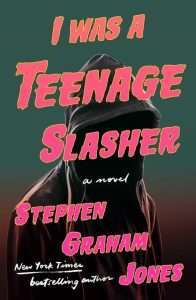 The book combines a fun exploration of familiar slasher movie tropes with a surprisingly poignant coming of age story. It’s brisker and breezier than Jones’ Indian Lake Trilogy, but he doesn’t skimp on the characterization or emotional dimension of the story.
The book combines a fun exploration of familiar slasher movie tropes with a surprisingly poignant coming of age story. It’s brisker and breezier than Jones’ Indian Lake Trilogy, but he doesn’t skimp on the characterization or emotional dimension of the story.
And while Jones retains the slasher movie elements horror fans would expect, he throws the audience a curveball by making the slasher quality transmitted, like lycanthropy. The killer’s intended victims likewise unconsciously place themselves in risky situations. It’s a fun twist with thought-provoking implications.
Read our review of I Was a Teenage Slasher by Stephen Graham Jones.
About I Was a Teenage Slasher1989, Lamesa, Texas. A small west Texas town driven by oil and cotton—and a place where everyone knows everyone else’s business. So it goes for Tolly Driver, a good kid with more potential than application, seventeen, and about to be cursed to kill for revenge. Here Stephen Graham Jones explores the Texas he grew up in, and shared sense of unfairness of being on the outside through the slasher horror Jones loves, but from the perspective of the killer, Tolly, writing his own autobiography. Find yourself rooting for a killer in this summer teen movie of a novel gone full blood-curdling tragic.
Read I Was a Teenage SlasherThe End and the Death Volume 3 by Dan AbnettPicked by Chris
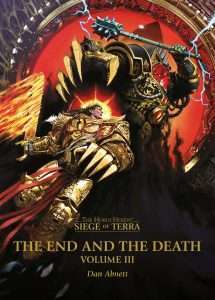 As a Warhammer 40,000 fan, I’ve waited for this telling for 30 years and Abnett’s twisting, layered and profoundly blesk telling of how the final day of the Horus Heresy went down absolutely fulfilled my expectations.
As a Warhammer 40,000 fan, I’ve waited for this telling for 30 years and Abnett’s twisting, layered and profoundly blesk telling of how the final day of the Horus Heresy went down absolutely fulfilled my expectations.
Abnett manages to pull together so many plot threads in satisfying ways in TE&TD3 and also throws more than a few surprises into the mix. There are things that long term 40k fans expected to happen that didn’t, things that were deep early canon that were confirmed, and he managed to give all his characters a suitable end to their narrative arc, which is mightily impressive given the literal cast of millions and the need to give long term and more recent fans a satisfying experience.
Plus, he sets up the next series–the Scouring (if Black Library choose to go there)–nicely, while not making this final book feel any less satisfying.
This is 40k at it’s bleakest, it’s most arcane, it’s most mind-bendingly chaotic and most achingly human all at once. This book included moments that had me confused with the left turn things had taken, literally shouting NO! out loud and also bits where I was all but cheering and weeping at the same time. There are elements here which are singular to this novel in the whole massive lexicon of that universe, but the themes are consistent and universal. In the grim darkness of the far future there is only war – but no small amount of wonder and perhaps just a tiny bit of hope as well.
It’s the hope that kills you.
About The End and the Death Vol. 3The Great Angel, Sanguinius, lies slain at his brother’s hand.
Terra burns as reality itself unravels and the greatest bastion of civilisation teeters on the brink of annihilation.
Desperate defenders gather, banding against the rabid traitor hordes. The Hollow Mountain, host to the pilgrims of Euphrati Keeler, is one of the last redoubts, held by the Dark Angels while the unclean host of Typhus lays siege. Malcador the Sigillite sits ablaze on the Golden Throne, trying to buy his master more time. But time is running out…
Guilliman races across the stars to reinforce the Throneworld. Will he return to ashes, where a Warmaster of Chaos has ascended to godhood, or will the Emperor have triumphed? And at what cost?
It all comes down to one final, climactic confrontation: the Emperor versus Horus. The father against the son.
Read The End and the Death Vol. 3Model Home by Rivers SolomonPicked by Rai
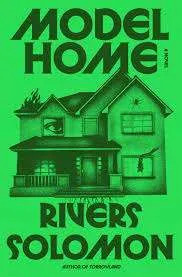 My favourite 2024 release was Model Home by Rivers Solomon (01 October 2024). Described as “a story of a haunted house and haunted people”, the novel is a well-woven literary horror that tackles the haunting of a family over three generations and how the intersectionality of their lives contributes to the ever-elusive menace. Solomon brings a genuine voice of lived experience to the tale that makes it all the more visceral and relatable. It’s a slow burn to start but ramps up dramatically. Ideal for fans of the haunted house, explorations into the dark side of humanity and those seeking something that makes you think.
My favourite 2024 release was Model Home by Rivers Solomon (01 October 2024). Described as “a story of a haunted house and haunted people”, the novel is a well-woven literary horror that tackles the haunting of a family over three generations and how the intersectionality of their lives contributes to the ever-elusive menace. Solomon brings a genuine voice of lived experience to the tale that makes it all the more visceral and relatable. It’s a slow burn to start but ramps up dramatically. Ideal for fans of the haunted house, explorations into the dark side of humanity and those seeking something that makes you think.
Read our review of Model Home by Rivers Solomon.
About Model HomeThe three Maxwell siblings keep their distance from the lily-white gated enclave outside Dallas where they grew up. When their family moved there, they were the only Black family in the neighborhood. The neighbors acted nice enough, but right away bad things, scary things―the strange and the unexplainable―began to happen in their house. Maybe it was some cosmic trial, a demonic rite of passage into the upper-middle class. Whatever it was, the Maxwells, steered by their formidable mother, stayed put, unwilling to abandon their home, terrors and trauma be damned.
As adults, the siblings could finally get away from the horrors of home, leaving their parents all alone in the house. But when news of their parents’ death arrives, Ezri is forced to return to Texas with their sisters, Eve and Emanuelle, to reckon with their family’s past and present, and to find out what happened while they were away. It was not a “natural” death for their parents . . . but was it supernatural?
Rivers Solomon turns the haunted-house story on its head, unearthing the dark legacies of segregation and racism in the suburban American South. Unbridled, raw, and daring, Model Home is the story of secret histories uncovered, and of a queer family battling for their right to live, grieve, and heal amid the terrors of contemporary American life.
Read Model HomeThe Last Shield by Cameron JohnstonPicked by Beth
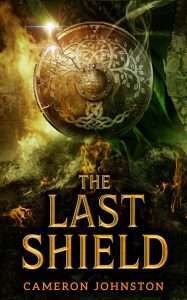 The Last Shield by Cameron Johnston is precisely what it says: “A gender-flipped Die Hard set in a mysterious castle, Cameron Johnston’s The Last Shield is an engaging fantasy read…” When I initially heard of this story, it had me at gender-flipped Die Hard. What a perfect elevator pitch for folks like me. I like big, mean, take-no-prisoners heroes. Often morally gray, “just doing my job,” type folks. This story has that in spades. Even better, the main character is female, i.e., gender-flipped, which is not often seen in books like this.
The Last Shield by Cameron Johnston is precisely what it says: “A gender-flipped Die Hard set in a mysterious castle, Cameron Johnston’s The Last Shield is an engaging fantasy read…” When I initially heard of this story, it had me at gender-flipped Die Hard. What a perfect elevator pitch for folks like me. I like big, mean, take-no-prisoners heroes. Often morally gray, “just doing my job,” type folks. This story has that in spades. Even better, the main character is female, i.e., gender-flipped, which is not often seen in books like this.
“How much fight can one broken old woman have left in her?”
As I immersed myself in the story, I couldn’t help but admire Johnston’s skill as a storyteller. He took a concept that could have easily veered into cheesy territory and turned it into something truly fantastic. The action is gripping, the dialogue is sharp, and the pacing is perfect. There’s not much more to say about how great this book is. If you’re a fan of The Maleficent Seven, you’re in for a treat with The Last Shield. Cameron, I salute you for creating my favorite book of 2024.
Read our review of The Last Shield.
About The Last ShieldThe ancient forest realm of Sunweald is bordered on two sides by far mightier nations – a precarious situation. At its centre, the Sunweald Palace is home to the Lord Regent and the heir to the throne, together with numerous precious and powerful artefacts. The Palace is protected by the realm’s elite Shields, dedicated to guarding the royal line against all foes.
A group of vicious brigands called the Wildwood Reivers have been stealing arcane artefacts and smuggling them across the borders, out of Sunweald. And the objects they most desire are stored in the mystical Wyrm Vault, hidden away deep in the bones of the earth, within the walls of the Palace itself.
As political and religious tensions mount, Sunweald’s druids prepare to enact rituals for the Summer Solstice – but the Wildwood Reivers and their treacherous allies have other plans. It falls to Briar, the commander of the Shields, to defend the ancient corridors and secret tunnels of the Palace. The odds may be against her, but she’ll see every enemy head adorning a spike or she’ll die trying…
Read The Last ShieldThe Escher Man by T.R. NapperPicked by Adrian Collins
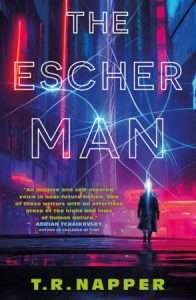 T.R. Napper is back with another mind-bending cyberpunk romp full of action, memory manipulation, and never quite knowing who you should be cheering for. Endel “Endgame” Ebbinghaus is a violent man. But he’s also a family man. And in The Escher Man he needs to make a decision about who he wants to be while his boss Mr. Long tries to retain him as Macau’s most brutal enforcer and hit man.
T.R. Napper is back with another mind-bending cyberpunk romp full of action, memory manipulation, and never quite knowing who you should be cheering for. Endel “Endgame” Ebbinghaus is a violent man. But he’s also a family man. And in The Escher Man he needs to make a decision about who he wants to be while his boss Mr. Long tries to retain him as Macau’s most brutal enforcer and hit man.
What Napper really knocks out of the park in this book is the ability to work with memory in his storyline in a way that hasn’t been done that magnificently (in my experience) since watching Guy Pearce in Memento. This approach creates this amazing, somewhat untrustworthy, reading experience where you are building a picture of who Endel is, what his actions mean, and what he’s trying to achieve while overwriting your previous experiences with him, in just the same way he’s having his memory consistently overwritten throughout the book. The Escher Man is just completely unputdownable and a must read for cyberpunk fans.
I’m going to say it again: T.R. Napper is the future of cyberpunk, and his body of work has created a terrifying future world I hope I never have to live in, but I pray to the publishing gods that I get to read plenty more about.
Read our review of The Escher Man by T.R. Napper.
About The Escher manYour name is Endel ‘Endgame’ Ebbinghaus. It is Saturday, 3 September, 2101. You’re head of security for Mister Long, boss of the Macau Syndicate, a drug cartel. Your memories are being wiped and re-written. You keep this log because you’re hard pressed to remember what day it is. But today is a special day, mate. This is your last day on the job.”
‘Endgame’ is a violent man, the perfect enforcer. But Endel is also a father and husband, haunted by the memories of his estranged family, and the life they once had.
Endel wants them back, and he wants out. But life in the syndicate isn’t one you can simply leave.
Endgame is a violent man. Or is he? In a world where memory manipulation is the weapon of choice for the powerful, Endel can’t tell friends and enemies apart anymore, can’t be sure if he’s a person or a tool.
Trapped in a taut, twisting nightmare, Endel must find a way to escape the labyrinth they’ve made of his mind, and take revenge.
Read The Escher ManPrevious year’s best of listsWhat’s that? Your bank account hasn’t taken enough pubishment? Check out our previous year’s best of lists and keep padding out that TBR like a champ.
20232022202120202019The post The best fantasy, horror, and Sci-fi books of 2024 appeared first on Grimdark Magazine.
December 23, 2024
REVIEW: Joker: Folie à Deux
Joker: Folie à Deux is the sequel to the incredibly successful Joker movie by Hangover creator Todd Phillips. It is also notable for being a massive bomb that has angered quite a few fans with its unconventional take. It is has Joaquin Phoenix return to the role of the titular Joker, and he is joined by co-star Lady Gaga as a version of Harley Quinn, a character with her own massive fanbase.
 Like the original Joker film, this film takes place in a Gotham City that doesn’t have a Batman and is a heightened version of America’s already troubled legal as well as social system. Defenders of the movie say it is about mental illness rather than the Joker himself. Detractors state it’s advertised as a Joker movie and should be a Joker movie. As a longtime Batman fan, enjoyer of grimdark, and neuroatypical person myself, what do I think? Does this movie deserve the hate it gets?
Like the original Joker film, this film takes place in a Gotham City that doesn’t have a Batman and is a heightened version of America’s already troubled legal as well as social system. Defenders of the movie say it is about mental illness rather than the Joker himself. Detractors state it’s advertised as a Joker movie and should be a Joker movie. As a longtime Batman fan, enjoyer of grimdark, and neuroatypical person myself, what do I think? Does this movie deserve the hate it gets?
Yeah, it kinda does.
The premise of Joker: Folie A Deux is that Arthur Fleck (Joaquin Phoenix) has been arrested for his murders from the previous movie and spends most of the film incarcerated at Arkham Asylum. While there, he meets a beautiful woman named Lee (Lady Gaga), who has fallen in love with his Joker persona but not Arthur Fleck. The film is all about Arthur’s relationship with his persona and the treatment of the mentally ill by society. There’s also a lot of singing and no original songs.
Essentially, I feel the movie is very much at odds with what the audience would expect from not just the title and the Joker as a character, but where the previous movie was leading. The previous Joker movie depicted the transformation of Arthur Fleck from being a mild-mannered decent-enough sort into a murderer for attention. It was making the questionable but not incomprehensible postulation that society pushes a person long enough, he’ll start pushing back in a violent horrifying manner.
It’s the premise of Taxi Driver and was also influenced strongly by The King of Comedy, both by Martin Scorsese. Fans justifiably expected that we’d see the Joker continue his crime spree and illustrate how society glorifies killers. It’s easy to see why Joker: Folie à Deux went over like a lead balloon among fans because they went to see Bonnie and Clyde or Natural Born Killers and instead got Chicago. A really bad, off-key, version of Chicago.
I can understand if Todd Phillips didn’t want to pursue this line of writing or felt the previous movie’s fans missed the mark but the fact is that Arthur in Joker: Folie à Deux doesn’t feel like he flows from the previous film. After becoming a multiple murderer and surrendering to his inner demons, this Arthur feels like a rubber band that snapped back to his previous goofy self. It doesn’t feel natural and it’s badly written.
Lee is barely a character in Joker: Folie à Deux and if feels like she is just there to represent the idea that Arthur has fans who do not care about him in the slightest, only the Joker. Except the reason that he became the Joker in the first place is because he wanted people to worship him. It’s a waste of Lady Gaga’s talents and the fact the soundtrack sucks is the most inexplicable part of this film. Given Lady Gaga made her own original soundtrack for this film and they didn’t use it, well, I think that summarizes what a car crash this all turned out to be.
As someone with mental health issues, I feel Todd just doesn’t understand us and doesn’t understand the appeal of the Joker either. We don’t need his defense. The first movie understood that he wasn’t a killer because he was “insane.” It was society and corruption that drove him to become a spree killer. It was society who misinterpreted what was a cry for help into something revolutionary. Joker: Folie à Deux just seems to say that none of that matters and Arthur should have just accepted being crushed like a bug. It even seems to endorse prisoner abuse.
Two thumbs down.
The post REVIEW: Joker: Folie à Deux appeared first on Grimdark Magazine.
December 22, 2024
REVIEW: Missing Pages by Mark Lawrence
Missing Pages is the new anthology from Mark Lawrence collecting all four short stories from his Library Trilogy. The anthology includes three previously published stories (“Overdue,” “Returns,” and “About Pain”) and one all-new story (“Tabula Rasa”).
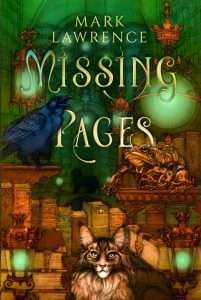 Missing Pages opens with “Overdue,” a story of mutual inspiration that also serves as an ode to independent bookshops. The story is surprisingly complex, as Mark Lawrence constructs a circle of literary influence that transcends geographical and temporal boundaries. The interwoven nature of the tale beautifully conveys how aspiring authors can discover inspiration in the most unlikely sources. I particularly enjoyed the unexpected symmetry of inspiration presented in “Overdue,” which left a great emotional impact on par with Lawrence’s best short stories.
Missing Pages opens with “Overdue,” a story of mutual inspiration that also serves as an ode to independent bookshops. The story is surprisingly complex, as Mark Lawrence constructs a circle of literary influence that transcends geographical and temporal boundaries. The interwoven nature of the tale beautifully conveys how aspiring authors can discover inspiration in the most unlikely sources. I particularly enjoyed the unexpected symmetry of inspiration presented in “Overdue,” which left a great emotional impact on par with Lawrence’s best short stories.
The next story in Missing Pages is “Returns,” which involves the search for a missing book, The Book of Many Stories, that must be returned to the Library. The search winds across space and time and may have implications for the librarian Yute’s missing daughter, who has been lost in the Library for over two decades. The book’s literal journey in “Returns” becomes analogous to our journey in reading the story.
The third story, “About Pain,” is Mark Lawrence’s homage to J.D. Salinger’s classic The Catcher in the Rye and probably my favorite story in Missing Pages. The goodest of good boys, the pitch-black dog Volente, brings an unwanted copy of Catcher to the protagonist, Holden, who detested the book when he was forced to read it in school. Upon returning Catcher to the library, Livira instructs Holden to read it every ten years and come back to tell her about it. The story then follows Holden through the decades as his life experiences make him appreciate new aspects of Catcher that he hadn’t yet considered. In a nice touch, “About Pain” also features Clovis Eventari, Evar’s imposing redheaded sister from The Book That Wouldn’t Burn.
“Tabula Rasa” is the fourth and final story in the anthology. The title is Latin for “clean slate” and serves as a mediation on (im)mortality and the limitless possibilities of the blank page. The story also includes new animal friend, an amphibian known as the epitoad who has a talent for reciting epigraphs.
Although the stories of Missing Pages are set in the same literary universe as the Library Trilogy, it’s not strictly necessary to read the main books of the trilogy before picking up this short story collection. Each of the stories is fully self-contained, and there are no spoilers here that would lessen your enjoyment of The Book That Wouldn’t Burn.
Altogether, the Library Trilogy has inspired some of Mark Lawrence’s best short stories to date, each one serving as a mediation on the power of stories in both reflecting and defining our common humanity. Missing Pages is a must-read for Mark Lawrence fans and anyone who shares the author’s passion for the written word.
Read Missing Pages by Mark LawrenceThe post REVIEW: Missing Pages by Mark Lawrence appeared first on Grimdark Magazine.
December 21, 2024
REVIEW: Obsidian: Revelation by Kajornwan
The sheer audacity of Kajornwan, formerly writing as Sienna Frost, to first publish an absolute masterpiece of a debut novel in Obsidian: Awakening, only to follow that up with a sequel in Obsidian: Revelation that just elevates the entire story to an unparalleled level of grimdark storytelling genius. As the title suggests, this is a sequel full of revelations, but more than that, it’s a sequel of consequences, endurance, trauma, painful growth, tentative hope, love, heartbreak, and just the most exquisite emotional turmoil. 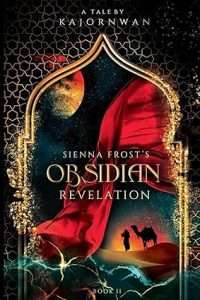 “I come from the desert. My people are prepared to die for something as fragile as honor and pride, however hard that is for a Rashai or a Samarran to understand. You can’t threaten us with death. It doesn’t work that way.”
“I come from the desert. My people are prepared to die for something as fragile as honor and pride, however hard that is for a Rashai or a Samarran to understand. You can’t threaten us with death. It doesn’t work that way.”
Now, as much as I gushed in my review of Obsidian: Awakening over on Before We Go Blog, there is no denying that it’s quite a slow-burn and boldly unconventional set-up book for the rest of the series. Yet those who have faith in Kajornwan’s vision and show patience and trust in the process (and, you know, those who were strong enough to survive book 1) are rewarded a thousandfold in this sequel. Though, fair warning, that is where Kajornwan’s kindness ends, because the emotional rollercoaster that she puts her characters, and by extension her readers, through in Obsidian: Revelation is absolutely relentless. But dammit, if it doesn’t all just hurt oh so good.
“Sometimes you have to sacrifice one to save a hundred more, or a thousand more. You can’t save victims, not all of them. If you want to change the world, you have to kill the beasts, and you’re going to have to live to do it. Close your ears and eyes if you must. There will be time for retribution, I promise you.”
We pick up roughly a month after the shocking and pivotal events at the end of Obsidian: Awakening, and tensions are now at an all-time high as the war between the Black and White desert comes ever closer to tearing the entire peninsula apart. But even more so than in book 1, it’s the battles that our seven damaged heroes are fighting in their own minds and the battles of wits and wills between them all that truly drive this entire tragically beautiful trainwreck of a narrative forward.
“Our past is never left behind,” he said. “It makes us who we are at any given time, and it dictates what we do in every situation. If you’re not willing to make peace with your past, then you will never find peace in life. A man who cannot find peace is a monster in disguise.”
The unexpected way that their journeys continued in Obsidian: Revelation probably surprised them just as much as it did me, and I loved how Kajornwan didn’t shy away from showing the heavy impact and devastating consequences of their actions in this sequel. Backstories are unveiled, loyalties shift, schemes unravel, promises are broken, old acquaintances bring new perspectives, bonds are tested beyond belief, and throughout it all we get to know these characters more intimately than I ever thought was possible. Both the most loveable, hateable and mysteriously enigmatic characters just leap off the page, and there were so many moments where I honestly didn’t know if I wanted to hug or strangle them all.
“”Run”, he said to the beast, to Fate, to destiny, to the gods who might be listening and the ones that didn’t when his prayers were declined. “Run away or say your prayers. Do it before I count to three. I am the son of Salar Muradi of Rasharwi and the last remaining Bharavi of the Vilarhiti. You do not get to threaten me, here or anywhere, without consequences. Run for your life, motherfucker, before I change my mind. I am the one hunting today, not you.”
For me, the unexpected growth of my favourite snarky half-blood prince Lasura was the absolute highlight of Obsidian: Revelation, not least because he managed to make me cry tears from both hysterical laughter and deep heartache on the same damn page. But honestly, I am not kidding when I say that I could (and would) write an entire essay dissecting every single character and interpersonal relationship in this book. Similarly to in Robin Hobb’s and Joe Abercrombie’s works, you can just feel that Kajornwan understands these characters (or should I say people?) on a deep human level, and the way that she unflinchingly explores themes of mental health, war, cultural identity, the fragility and complexity of parent/child relationships, and the dangerously thin line between love and hate is nothing short of masterful.
“You cannot win your battles without a place to land when you fall, or with a heart that beats for nothing and no one. Love always comes at a price, but it’s what gives us the strength to fight, not our weakness.”
Moreover, it’s wild to me how we’ve got sword fights to the death, a suicide mission of a prison break, an escalating war, and earth-shattering quakes to survive in Obsidian: Revelation, and yet some of the most pulse-pounding scenes are the ones where two characters are simply having a conversation with each other. After all, words are the most dangerous weapons of all, and what hurts more than being cut with secrets, lies, and harsh truths? The sheer number of times that a killer line of dialogue sent shivers down my spine or made me audibly go: “OH SHIT” is honestly not even funny, and I don’t think I have ever highlighted so many profound or hard-hitting quotes before in all my years of reading.
“There are lines that cannot be crossed; things you cannot take from a man and walk out alive. I am that line, and you know it. The entire Salasar knows it. Touch me, and he will give up the throne to see you die.”
The tension and danger truly bleeds off every single page, and whether it was the development of the sick dynamic between Zahara (a.k.a. the most badass bitch queen) and Muradi, the unravelling of Djari and the Sparrow’s bond, the complicated alliance between Lasura and Djari, Deo’s unpredictable scheming, or the forbidden, star-crossed queer romance between Baaku and Nazir, they all just had me in an absolute chokehold. And don’t even get me started on how much I adore the fearsome women in Obsidian: Revelation, the way that they take life by the balls and do anything to survive in a world that is out to get them is honestly beyond inspiring to me.
“The world she lived in hadn’t allowed her to go through life without incident. She hadn’t gotten used to it -no woman could- but one could shut it out sometimes, or simply try to endure.”
Now, I can see how some readers might feel like the unfolding of a few events maybe felt too unbelievably lucky or convenient, but I would personally argue that the level of ‘divine intervention’, if you will, fits perfectly with the larger-than-life legendary quality that permeates every aspect of Kajornwan’s storytelling; there’s this constant sense of dread that larger powers are pulling the strings, and Fate is proven to be an inescapable sadistic bitch time and again. In that way, the Obsidian series reminds me of Guy Gavriel Kay’s or Ken Liu’s low-magic yet entrancingly epic approach to fantasy storytelling, except her skillful prose speaks to my soul in a way that even those masters of their craft have never managed to.
“There would be change, of course, in the pattern of things. That tapestry, after all, had yet to be woven. The gods had plans, yes, but plans changed, and divine beings rarely worked with each other. What was the point of getting visions, anyway, if one couldn’t use them to alter the future? The question was which part of the future to alter, and how it would accommodate his needs.”
There truly isn’t a single scene, sentence or word in this 800+ page chunker that doesn’t carry an incredible amount of weight, tension, and impact, and there are probably another 800 pages worth of content just waiting to be discovered in all the subtext and hidden layers. Obsidian: Revelation is one of those rare books that begs to be savoured and which I actively slowed down to read, both because I didn’t want it to and because I was afraid that it might just end me before getting to the last page.
“I don’t want to die old, safe, and bored with a life story nobody can stretch past a page. I may never be the hero everyone needs, but at least in my own story I can be one. And no good heroes ever run from scars or pain.”
Kajornwan’s relentless storytelling is absolutely not for the faint of heart, but to those who can stomach all the brutality, (sexual) violence, deadly toxicity, and emotional damage, I simply cannot recommend it highly enough. With its rich and breathtaking Middle-Eastern flavoured world building, dynamic cast of damaged and morally questionable heroes, and exceptionally immersive and soul-stirring prose, the Obsidian series is an unmissable and unforgettable emotional journey that just creeps under your skin and will leave you a changed person by the end; it’s not just one of my personal all-time favourites, but I would dare say it’s one of the best, well-crafted and stunningly told stories out there, period.
Thank you to the author for providing me with an eARC in exchange for an honest review. All opinions are my own. Obsidian: Revelation is scheduled for release on December 25th, 2024.
Read Obsidian: Revelation by KajornwanThe post REVIEW: Obsidian: Revelation by Kajornwan appeared first on Grimdark Magazine.
December 17, 2024
Tim Miller delivers another masterpiece anthology with Secret Level S1
Last Updated on December 18, 2024
Tim Miller, take a bow, mate. After the success of Love, Death, & Robots (2019, 2021, 2022) and (of course) Deadpool (2016), I think we can all agree we expected amazing things when Miller announced he’d be partnering with Amazon Prime to deliver another anthology series, Secret Level. With fifteen short episodes based on fifteen different gaming franchises, Miller had plenty to play with, and Secret Level blew away my expectations.
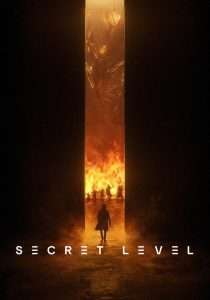
While the episodes are going to appeal to people based on what they grew up playing and the type of stories they enjoy, there were a few episodes that really stood out to me–most in the first half of the season. The Queen’s Cradle (Dungeon’s & Dragons) really captured that feeling of fast camaraderie, over the top scenery chewing, and self sacrifice that playing this game for the last six years online with mates has made me feel. The Once and Future King (The New World) was absolutely hilarious, with Schwarzenegger cracking me up as he tried to take rulership of a land of immortals. Good Conflict (Crossfire) and Asset Management (Armoured Core) are both going to appeal to grimdark fans with their focus on morally grey characterisation in their character casts. Concord: Tale of the Implacable gathered together a crew of rogues looking to stick their middle fingers up at the intergalactic corporation in control of all the trade routes while simultaneously fighting each crew member’s own self interests.
The really big surprise for me was Pac Man: Circle. Pretty much every anthology you watch or read will have a story or episode (or two) that doesn’t work for you. Seeing the title of this episode, I definitely thought this one was going to be it for Secret Level. It immediately destroyed my expectations of what that episode might be about and became one of my favourites, and I think one of the episodes that grimdark fans are going to enjoy the most. It’s utterly fucking brutal, and I could not tear my eyes from the screen.
However, most importantly for this particular fan and, I feel, a significant portion of our readers, we need to talk about that Warhammer 40,000 episode, And They Shall Know No Fear. It’s the best piece of 40k animation since Syama Pedersen delivered Astartes, hands down. Gone are the days of bulky moving Space Marines looking like roided-up bodybuilders who can’t reach their lower backs or turn right. Pedersen was included in the creation of the episode, and his smooth moving, vicious and bloody demigods in power armour scathing their way through the enemy style is there in absolute spades. It is a beautifully delivered, action-packed vignette, and even features Titus from the brilliant 2024 videogame Space Marine 2.
The delivery of And They Shall Know No Fear, this month’s announcement that the Henry Cavill led efforts to bring the franchise to screens has finally been signed off between Amazon and Games Workshop (Warhammazon), and the wild success of 2024’s Space Marine 2 video game, brings the future possibilities of this universe to life. For 40k fans, now is probably just about the greatest time in fan history to still be this side of the kiln doors.
As with all anthologies, there were some stories that I didn’t enjoy as much as others, but as with pretty much all of Miller’s animated anthologies so far, there is far more to like than dislike. Visually stunning, stacked with fascinating stories set in worlds we all love, Miller has helmed another franchise that’s going to have an army of fans waiting for more. I can’t wait for Season 2 to hit the screen!
Watch Secret Level on PrimeThe post Tim Miller delivers another masterpiece anthology with Secret Level S1 appeared first on Grimdark Magazine.

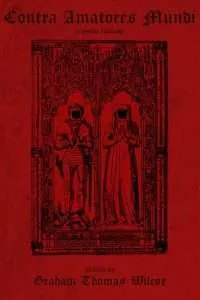 Read on Amazon
Read on Amazon

